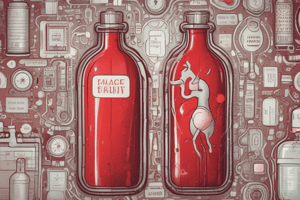Podcast
Questions and Answers
In arterial blood gas (ABG) sampling, what is the primary risk associated with using the femoral artery as a puncture site, particularly in elderly patients or those on anticoagulants?
In arterial blood gas (ABG) sampling, what is the primary risk associated with using the femoral artery as a puncture site, particularly in elderly patients or those on anticoagulants?
- Increased risk of arteriospasm due to the artery's proximity to nerve endings.
- Difficulty in obtaining a sample due to the artery's depth beneath the subcutaneous fat.
- Elevated risk of hematoma formation due to the artery's higher pressure and superficial location. (correct)
- Higher likelihood of infection due to the groin area being prone to contamination.
Why are capillary PO2 measurements considered of limited value in estimating arterial oxygenation?
Why are capillary PO2 measurements considered of limited value in estimating arterial oxygenation?
- Capillary blood samples are more susceptible to contamination, leading to inaccurate readings.
- The heparinized capillary tubes used for collection interfere with accurate oxygen measurement.
- The warming process prior to capillary puncture artificially elevates PO2 levels.
- Capillary PO2 levels are significantly influenced by local metabolic activity and venous admixture. (correct)
In blood culture collection, why is the cleansing of the venipuncture site considered the most critical step?
In blood culture collection, why is the cleansing of the venipuncture site considered the most critical step?
- To prevent the activation of the patient's immune response, which can interfere with bacterial growth.
- To ensure that the antiseptic does not alter the morphology of potential pathogens.
- To reduce patient discomfort during the venipuncture, ensuring a sufficient sample volume is obtained.
- To minimize the risk of introducing skin flora into the blood sample, leading to false-positive results. (correct)
What is the rationale behind warming the puncture site before collecting capillary blood gas samples?
What is the rationale behind warming the puncture site before collecting capillary blood gas samples?
What is the most appropriate antiseptic to use for cleaning the venipuncture site during blood culture collection, according to the content?
What is the most appropriate antiseptic to use for cleaning the venipuncture site during blood culture collection, according to the content?
When performing arterial blood gas sampling, what is the most important consideration regarding the radial artery as the preferred site?
When performing arterial blood gas sampling, what is the most important consideration regarding the radial artery as the preferred site?
In the context of blood culture collection, what is the rationale for allowing the tops of blood culture bottles to air dry after disinfection?
In the context of blood culture collection, what is the rationale for allowing the tops of blood culture bottles to air dry after disinfection?
Why are blood cultures indicated for patients with Fever of Unknown Origin (FUO)?
Why are blood cultures indicated for patients with Fever of Unknown Origin (FUO)?
What is the primary purpose of performing a Glucose Tolerance Test (OGTT) during prenatal care?
What is the primary purpose of performing a Glucose Tolerance Test (OGTT) during prenatal care?
Why is the timing of specimen collection critical in Therapeutic Drug Monitoring (TDM) for drugs with short half-lives, such as gentamicin or tobramycin?
Why is the timing of specimen collection critical in Therapeutic Drug Monitoring (TDM) for drugs with short half-lives, such as gentamicin or tobramycin?
During an OGTT, a patient becomes nauseous after consuming the glucose load. What is the most appropriate course of action for the phlebotomist?
During an OGTT, a patient becomes nauseous after consuming the glucose load. What is the most appropriate course of action for the phlebotomist?
What is the rationale for collecting TDM specimens in plain red-top tubes without serum separators?
What is the rationale for collecting TDM specimens in plain red-top tubes without serum separators?
A physician orders a TDM for a patient receiving multiple medications. What is the primary concern in this scenario?
A physician orders a TDM for a patient receiving multiple medications. What is the primary concern in this scenario?
For which of the following scenarios is Therapeutic Drug Monitoring (TDM) most essential?
For which of the following scenarios is Therapeutic Drug Monitoring (TDM) most essential?
A phlebotomist receives an order for a peak level TDM draw for an antibiotic to be collected 30 minutes post-infusion, but the infusion is delayed by an hour. What is the appropriate action?
A phlebotomist receives an order for a peak level TDM draw for an antibiotic to be collected 30 minutes post-infusion, but the infusion is delayed by an hour. What is the appropriate action?
A phlebotomist has collected a TDM specimen. What is the proper procedure for handling and storing the specimen to avoid interference?
A phlebotomist has collected a TDM specimen. What is the proper procedure for handling and storing the specimen to avoid interference?
Flashcards
Blood Gases
Blood Gases
Analysis of blood to assess respiratory function and acid-base balance.
Blood Cultures
Blood Cultures
A test to identify bacteria or other microorganisms in the bloodstream.
Blood Gases Use
Blood Gases Use
Used to diagnose and manage respiratory diseases by assessing blood pH, PaCO2 and PaO2.
Capillary Blood Gases
Capillary Blood Gases
Signup and view all the flashcards
Warming Before Puncture
Warming Before Puncture
Signup and view all the flashcards
Radial Artery
Radial Artery
Signup and view all the flashcards
Femoral Artery
Femoral Artery
Signup and view all the flashcards
Blood Cultures Indication
Blood Cultures Indication
Signup and view all the flashcards
Chlorhexidine gluconate
Chlorhexidine gluconate
Signup and view all the flashcards
Glucose Tolerance Test (OGTT)
Glucose Tolerance Test (OGTT)
Signup and view all the flashcards
OGTT Tube Color
OGTT Tube Color
Signup and view all the flashcards
Therapeutic Drug Monitoring (TDM)
Therapeutic Drug Monitoring (TDM)
Signup and view all the flashcards
When is TDM needed?
When is TDM needed?
Signup and view all the flashcards
Peak Drug Level
Peak Drug Level
Signup and view all the flashcards
Trough Drug Level
Trough Drug Level
Signup and view all the flashcards
TDM Tube Type
TDM Tube Type
Signup and view all the flashcards
Study Notes
Special Technique: Specific Laboratory Tests
- Four tests are discussed including blood gases, blood cultures, glucose tolerance test, and therapeutic drug monitoring.
Blood Gases
- Blood gases help in the diagnosis and management of respiratory disease.
- Capillary blood gases are done by capillary puncture especially on babies, commonly used in arterial punctures for estimating acid-base balance and ventilation adequacy.
- Capillary PO2 measurements have little value in estimating arterial oxygenation.
- Skin is punctured or a small incision made with a lancet in highly vascularized areas like the heel, finger, or toe.
- The area is warmed before puncture to accelerate blood flow reducing differences between arterial and venous gas pressures, with collection into a heparinized glass capillary tube.
- Arterial blood gases (ABGs) uses the radial artery on the thumb side of wrist, but its small size requires skill.
- The femoral artery is a large artery in the groin used for arterial puncture by physicians.
- Scalp and umbilical arteries can be used in infants.
- A hematoma is likely to occur due to higher arterial pressure especially in elderly or patients on anticoagulants.
- Arteriospasm might occur, where the artery has a reflex condition in response to pain or anxiety.
Blood Cultures
- Blood cultures are indicated for patients with Fever of Unknown Origin (FUO).
- Cleansing the venipuncture site is critical, using chlorhexidine gluconate.
- Tops of blood culture bottles must me cleansed according to manufacturer's directions and allowed to air dry, commonly a 70% Isopropyl alcohol solution
- One aerobic and one anaerobic sample should be drawn.
Glucose Tolerance Test (OGTT)
- This screens for gestational diabetes typically using tubes with gray stopper
- Fasting blood is drawn, patient drinks a glucose load (75g of glucose) and drawing blood 2 hours post consumption
- Patients should be monitored for signs of nausea.
Therapeutic Drug Monitoring (TDM)
- TDM evaluates drug concentrations for several reasons.
- Checks for highly toxic drugs.
- Checks for when over or under dosing can have serious consequences
- Checks for when multiple drug usage may alter drug actions.
- Monitors when patients metabolize drugs differently.
- Checks for drug effectiveness.
- Timing is critical for drugs with short half lives, gentamicin, tobramycin, procainamide.
- Timing is less strict for drugs like phenobarbital or digoxin.
- Specimen collection should not be done immediately after a dose, usually 30 minutes after for peak levels and 15 minutes before next dose for trough level.
- Trough measures the lowest drug level, peak shows the highest.
- Use plain red top collection tubes, no additives or serum separators.
- Keep specimens upright, away from the stopper to avoid interfering substances.
Studying That Suits You
Use AI to generate personalized quizzes and flashcards to suit your learning preferences.




